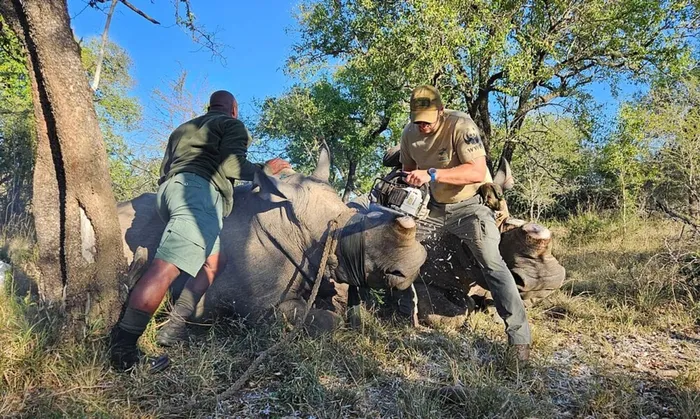Helicopters, chainsaws, and hope - Inside the fight to save Hluhluwe-iMfolozi's rhinos

An ongoing mass dehorning operation in KwaZulu-Natal’s Hluhluwe-iMfolozi Park is being hailed as a critical effort to save rhinos from poaching threats. Picture: Ursina Rusch / WWF Black Rhino Range Expansion Project
KwaZulu-Natal’s Hluhluwe-iMfolozi Park has become the focal point of an important conservation effort aimed at protecting its rhino population from the ongoing threat of poaching.
A multi-stakeholder mass dehorning operation, one of the largest in the park since the 1960s, mirrors the efforts of Ian Player’s Operation Rhino, which saved the white rhino from the brink of extinction.
According to Save The Rhino, rhino horn, primarily used in traditional Chinese medicine, has increasingly become a symbol of wealth and success, especially in countries like Vietnam.
South Africa, home to the majority of the world’s rhinos, faces severe poaching threats from international criminal gangs armed with sophisticated equipment. These poachers often use tranquillisers to bring rhinos down before hacking off their horns, leaving the animals to suffer slow, painful deaths.

The high price of rhino horn, driven by its scarcity, exacerbates poaching, putting immense pressure on dwindling rhino populations. Although the international trade in rhino horn has been banned since 1977, domestic trade remains legal in South Africa, with ongoing calls to legalise international trade as well.
Despite its long history in traditional medicine, the medicinal benefits of rhino horn remain scientifically unproven. Nevertheless, the belief in its efficacy continues to fuel demand, threatening the survival of rhino species worldwide.
In a first-hand account of the mass dehorning operation, WWF Black Rhino Range Expansion population manager Ursina Rusch describes the daily rigour and urgency involved. We work in teams of five, processing 30 to 40 rhinos a day,” she said, the teams are tasked with not only removing the rhino horns but also collecting valuable biological samples for genetic research.
“Each team of five (there are usually two or three such teams on the go) is shuttled from one rhino to the next by a large helicopter, after the vet in a smaller helicopter has darted the rhino,”
Rusch explained. This aerial method of getting around is used in parts of the park where there are no roads, and teams can’t be driven in by vehicle.
Dehorning is widely seen as a non-lethal deterrent to poachers, with rhino horns often being the primary target. The operation has already led to the discovery of many rhinos that have survived poaching attempts.
"During the dehorning operation, we encountered rhinos with old bullet wounds—evidence of past attacks," Rusch recounted, emphasising the risks these animals face daily.
Each day, the teams work alongside veterinarians and helicopter crews to locate and immobilise the animals before the horns are carefully removed with chainsaws. The rhino horns, made of keratin like human fingernails, are catalogued, microchipped, and secured in a facility.
While the practice is considered controversial by some, Rusch stressed its necessity. "It doesn't hurt the rhinos, and in a world where the threat of poaching is ever-present, this is an urgent measure we must take."
In addition to dehorning, the operation provides invaluable insights into rhino behaviour, particularly in response to poaching. Rusch noted an unusual trend of young rhinos frequently pairing with adult bulls, a result of the high number of poaching incidents that have left calves orphaned.
"Larger calves that are weaned often look for any other rhinos they can team up with to survive,” she explained. These findings shed light on the social dynamics of rhinos impacted by poaching and are critical for future conservation strategies.
Besides dehorning rhinos, the teams also come across peculiar sights, “like a large broken off elephant tusk that we picked up to take to safe storage.”
“The joke going around was that we’d dehorned an albino rhino when we carried the elephant tusk from the helicopter, along with the rhino horns from that morning,” said Rusch, laughing.
Every horn is catalogued and microchipped, and sent to a secure facility.
Despite the physical toll of the work—long hours in difficult terrain, often battling fatigue—Rusch and her team remain dedicated to the cause. "No one involved in this historic operation would trade this work for the world," Rusch concluded.
IOL
Fight to end rhino poaching goes on
Drop of 80% in rhino poaching credited to HiP dehorning plan
PICS: Dehorning proves effective in Hluhluwe-iMfolozi Park as rhino poaching plummets
WATCH: White rhino orphan calf joins rhino sanctuary for supportive care
WATCH: Examination and X-rays for critically endangered black rhino calf born at the Care for Wild Rhino Sanctuary
Tech-driven conservation: How Sabi Sand is winning the battle against poaching